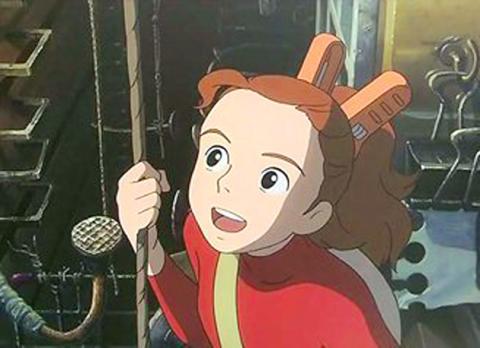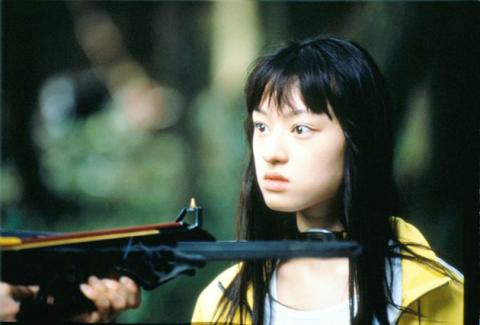The Man From Nowhere
This kinetic, violent action thriller by director Lee Jeong-beom has already proven a big hit in his native South Korea and on the festival circuit. The story of a withdrawn former special ops agent who gets drawn back into a life of violence to save a young girl is hardly new, but actor Won Bin brings enormous energy to the lead role, and the bad guys (and police) get dispatched in a brutal fashion. The Man From Nowhere, with its subplots taking in illegal organ harvesting and child trafficking, aims to shock. The gritty feel of the cinematography and a willingness to take the violence that extra mile (a torture scene using a hair dryer is much praised by Internet fans) ensures that the film can barrel through a few narrative absurdities to provide two hours of gripping entertainment.
The Borrowers (Kari-gurashi no Arrietty)

Japanese animation from Studio Ghibli directed by veteran animator Hiromasa Yonebayashi with a script by the celebrated animator and studio cofounder Hayao Miyazaki (Spirited Away and Howl’s Moving Castle). The story is taken from Mary Norton’s 1952 novel The Borrowers. This is the second time that the studio has borrowed from a well-known Western work, the last occasion being in 2008 for Gedo Senki, based on Ursula Le Guin’s Earthsea novels. While Gedo Senki featured a full cast of outlandish magical creatures and grand quests, The Borrowers tells the story of an ordinary family, ordinary except for the fact they are 10cm tall and live within a regular Tokyo home, taking what they need from the human environment (hence the title). The production has been praised for its delicate touch and its generally strong characterization. Environmental issues are dealt with, but there is also a strong mood of youthful adventure, making this an ideal movie outing for the whole family.
Battle Royale 3D (Batoru Rowaiaru)
A 10th anniversary reissue of a film that first came to Taiwan in 2000 but failed to get by the censors due to its extremely graphic violence. Directed by the late celebrated filmmaker Kinji Fukasaku, and starring the inimitable Takeshi Kitano, Battle Royale’s story is simple: School violence has got out of hand and the state intervenes. It arbitrarily takes off whole classes of highschoolers to an island and tells them that only one will survive. They are given some food, a weapon of sorts, and the contest is opened by the teacher who recommended their participation. They soon discover that they must either fight or die. The high body count and the vicious, bloody action does not totally drown out the director’s deeper interests in the violence that is inherent in all of us. Battle Royale is much more than a gore fest and still manages to shock even a decade after its first release.

Blood Ties (頭七還魂夜)
The first feature film by young Singaporean director Chai Yee-wei (蔡于位), starring actress Cheng Pei-pei (鄭佩佩), a huge star in the 1960s whose career made a resurgence with her role as Jade Fox in Ang Lee’s (李安) Crouching Tiger, Hidden Dragon. Cheng’s presence in Blood Ties might actually be the most interesting thing about this conventional story of a dead police officer taking possession of the body of a 13-year-old girl to exact vengeance on the gang that killed him and his wife.
Eloise

A Spanish film that performed well on the gay cinema festival circuit. While boasting solid performances and two beautiful leads, Eloise is a niche product. Directed by Jesus Garay, Eloise is the story of a nice girl, Asia, who is targeted for seduction by Eloise. The film opens with Asia in a coma, and the main body of the film is made up of her struggle with her sexuality and our discovery of how she came to be in that predicament. There are the usual dollops of art house sex and a generally positive portrayal of a lesbian relationship.
The Hairy Tooth Fairy 2 (El Raton Perez 2)
Low-budget CGI children’s film about a mouse who works nights as a tooth fairy, picking up teeth placed under children’s pillows, selling them on and giving the money to the children. The first installment was successful enough in the Spanish-speaking market to spawn a sequel. This time the hero, the mouse Perez, meets up with a girl mouse, learns to dance and then the two must avoid capture by a fiendish circus manager who wants to exploit them as a money-spinner. Mixture of animation and live action, but for audiences brought up on Disney, Dreamworks and Pixar, it’s low-rent. If you want to watch rats being cute, catch one of the endless reruns of Ratatouille on the Disney Channel.

I Am Love
There is enough haute couture, chandeliers and champagne in I Am Love to put this contemporary story into the category of costume drama. Director Luca Guadagnino has done a splendid job in giving us a glimpse of the Italian financial aristocracy through the story of an affair between Emma (Tilda Swinton), the young, inexperienced wife of an industrialist, and Antonio (Edoardo Gabbriellini), a young chef. Emma’s flight from a stultifying society into the arms of passion offers little that is new, and Guadagnino’s considerable talent is largely to be placed at the service of pretending that a story taken directly from the pages of pulp romance is something better than it really is.




The canonical shot of an East Asian city is a night skyline studded with towering apartment and office buildings, bright with neon and plastic signage, a landscape of energy and modernity. Another classic image is the same city seen from above, in which identical apartment towers march across the city, spilling out over nearby geography, like stylized soldiers colonizing new territory in a board game. Densely populated dynamic conurbations of money, technological innovation and convenience, it is hard to see the cities of East Asia as what they truly are: necropolises. Why is this? The East Asian development model, with

June 16 to June 22 The following flyer appeared on the streets of Hsinchu on June 12, 1895: “Taipei has already fallen to the Japanese barbarians, who have brought great misery to our land and people. We heard that the Japanese occupiers will tax our gardens, our houses, our bodies, and even our chickens, dogs, cows and pigs. They wear their hair wild, carve their teeth, tattoo their foreheads, wear strange clothes and speak a strange language. How can we be ruled by such people?” Posted by civilian militia leader Wu Tang-hsing (吳湯興), it was a call to arms to retake

This is a deeply unsettling period in Taiwan. Uncertainties are everywhere while everyone waits for a small army of other shoes to drop on nearly every front. During challenging times, interesting political changes can happen, yet all three major political parties are beset with scandals, strife and self-inflicted wounds. As the ruling party, the Democratic Progressive Party (DPP) is held accountable for not only the challenges to the party, but also the nation. Taiwan is geopolitically and economically under threat. Domestically, the administration is under siege by the opposition-controlled legislature and growing discontent with what opponents characterize as arrogant, autocratic

When Lisa, 20, laces into her ultra-high heels for her shift at a strip club in Ukraine’s Kharkiv, she knows that aside from dancing, she will have to comfort traumatized soldiers. Since Russia’s 2022 invasion, exhausted troops are the main clientele of the Flash Dancers club in the center of the northeastern city, just 20 kilometers from Russian forces. For some customers, it provides an “escape” from the war, said Valerya Zavatska — a 25-year-old law graduate who runs the club with her mother, an ex-dancer. But many are not there just for the show. They “want to talk about what hurts,” she